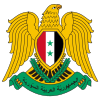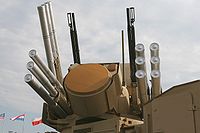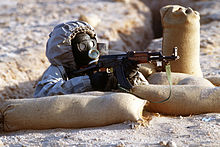- Syrian Armed Forces
-
Syrian Armed Forces
Armed Forces of Ba'ath Party
Coat of Arms of the Syrian Arab RepublicFounded 1946 Service branches Syrian Arab Army
Syrian Arab Navy
Syrian Arab Air Force
Syrian Arab Air Defense Force
Syrian Military Intelligence
Syrian Arab Air Force IntelligenceHeadquarters Damascus Leadership President of Syria Bashar al-Assad Minister of Defence Lieutenant General Dawoud Rajiha Manpower Military age 18 Conscription Mandatory for all males
(below 2010 est.)[1]Available for
military service5,889,837 males, age 16-49,
5,660,751 females, age 16-49Fit for
military service5,055,510 males, age 16-49,
4,884,151 females, age 16-49Reaching military
age annually256,698 males,
244,712 femalesActive personnel 304,000[2][3] (ranked 13th) Reserve personnel 342,500[3][4] Expenditures Budget $1.8 billion (FY11)[3][4] Percent of GDP 3.5% (FY11)[3][4] Industry Foreign suppliers  Russia
Russia
 Belarus
Belarus
 Iran
Iran
 North Korea[5]
North Korea[5]Related articles History Military history of Syria
1948 Arab-Israeli War
March 1949 Syrian coup d'état
The War over Water
1966 Syrian coup d'état
Six Day War
Black September in Jordan
Yom Kippur War
Islamic uprising in Syria
Syrian occupation of Lebanon
1982 Lebanon War
Gulf War
2011 Syrian uprisingThe Syrian Armed Forces or Armed Forces of Ba'ath Party are the military forces of Syria. They consist of the Army, Navy, Air Force, and Air Defense Force.
Contents
Manpower
The President of Syria is the commander in chief of the Syrian armed forces, comprising some 646,500 troops upon mobilization. The military is a conscripted force; males serve in the military upon reaching the age of 18.[6] The obligatory military service period is being decreased over time, in 2005 from two and a half years to two years, in 2008 to 21 months and in 2011 to year and a half.[7] About 20,000 Syrian soldiers were deployed in Lebanon until April 27, 2005, when the last of Syria's troops left the country after three decades.[6]
Leadership
The majority of the soldiers in the Syrian armed forces are Alawites, like President Bashar al-Assad. Alawites make up 12 percent of the Syrian population but are estimated to make up 70 percent of the career soldiers in the Syrian army.[8][9] Of the 200,000 or so career soldiers in the Syrian army, 140,000 are Alawites.[10] A similar imbalance is seen in the officer corps where some 80 percent of the officers are Alawites. The military’s most elite divisions, the Republican Guard and the 4th Mechanized Division, which are commanded by Basher's brother, are exclusively Alawite. Most of Syria’s 300,000 conscripts and air force pilots are, however, Sunni.[8][11] Because of the Alawite composition of the Syrian armed forces, its interests are closely aligned with those of President Bashar al-Assad and the Assad family.
Procurement
The breakup of the Soviet Union — long the principal source of training, material, and credit for the Syrian forces — may have slowed Syria's ability to acquire modern military equipment. It has an arsenal of surface-to-surface missiles. In the early 1990s, Scud-C missiles with a 500-kilometer range were procured from North Korea, and Scud-D, with a range of up to 700 kilometers, is allegedly being developed by Syria with the help of North Korea and Iran, according to Zisser.[12]
Syria received significant financial aid from Persian Gulf Arab states as a result of its participation in the Persian Gulf War, with a sizable portion of these funds earmarked for military spending. In 2005, Russia forgave Syria of three-fourths, or about $9.8 billion, of its $13.4 billion Soviet-era debt. Russia wrote off the debt in order to renew arms sales with Syria.[13] As of 2011, arms contracts with Russia, Syria's main arms supplier, were worth at least $4 billion.[5][14][15][16]
History
Involvement in military conflict
- 1948 Arab-Israeli War (against Israel)
- Six Day War (against Israel)
- Black September (against Jordan)
- Yom Kippur War (against Israel)
- Islamic uprising in Syria (internal)
- Lebanese Civil War (1975–1990),
- 1982 Lebanon War (against Lebanese militias, the PLO, and Israel)
- Persian Gulf War (against Iraq)
- 2011 Syrian uprising (internal)
The Syrian armed forces were involved in internal fighting during the Islamic uprising in Syria in the 1980s, mostly notable during the Hama Massacre. And in 2011, the Syrian army was deployed along with security police to repress the public uprising in many Syrian cities. See the timeline of the 2011 Syrian uprising.
Development of Syrian military
The French Mandate volunteer force, which would later become the Syrian army, was established in 1920 with the threat of Syrian−Arab nationalism in mind. Although the unit's officers were originally all French, it was, in effect, the first indigenous modern Syrian army. In 1925 the unit was designated the Levantine Special Forces (Troupes Spéciales du Levant). In 1941 during World War II, the force participated in a futile resistance to the British and Free French invasion that ousted the Vichy French from Syria during Syria–Lebanon Campaign. After the Allies takeover, the army came under the control of the Free French and was designated the Levantine Forces (Troupes du Levant).[17]
French Mandate authorities maintained a gendarmerie to police Syria's vast rural areas. This paramilitary force was used to combat criminals and political foes of the Mandate government. As with the Levantine Special Forces, French officers held the top posts, but as Syrian independence approached, the ranks below major were gradually filled by Syrian officers who had graduated from the Military Academy at Homs, which had been established by the French during the 1930s. In 1938 the Troupes Spéciales numbered around 10,000 men and 306 officers (of whom 88 were French, mainly in the higher ranks). A majority of the Syrian troops were of rural background and minority ethnic origin, mainly Alawis, Druzes, Kurds, and Circassians. By the end of 1945, the army numbered about 5,000 and the gendarmerie some 3,500. In April 1946, the last French officers left Syria; the Levantine Forces then became the regular armed forces of the newly independent state and grew rapidly to about 12,000 by the time of the 1948 Arab−Israeli War, the first of four Arab−Israeli wars between 1948 and 1986 not counting the 1982 Israeli invasion of Lebanon.[18]
International disputes
Since 1967, most of the Golan Heights territory of South West Syria is under Israeli occupation. Since 1973, the cease-fire line has generally been respected by both sides, with very few incidents. Syria does not recognize the State of Israel. Syria and Lebanon both publicly maintain that the Israeli-annexed Shebaa farms area on the northern Golan is in fact Lebanese territory, and that Israel has therefore not withdrawn fully from Lebanon; Israel and the UN both dispute this, claiming the Shebaa area is part of the Golan heights territory, which the UN considers Israeli-occupied and Israel since annexation considers Israeli territory.
Syria was invited into Lebanon by that country's president in 1976, to intervene on the side of the government against a rebellion of PLO and Lebanese forces. Syrian forces lingered in the country throughout the Lebanese civil war, and eventually brought most of the nation under their control, in conjunction with a power-struggle with Israel, which occupied part of the south of the country from 1978. Following the end of the civil war in 1990, Syrian forces maintained what was in effect a military occupation of Lebanon until 2005, when they were forced out by widespread public protest and international pressure, following the murder of Rafiq al-Hariri. Syrian forces have been accused of involvement in that murder, as well as continued meddling in Lebanese affairs, and an international investigation into the Hariri killing and several subsequent bomb attacks has been launched by the UN.
Syria also considers the Hatay Province (referred to as Iskanderoun or Alexandretta) of Southern Turkey to be Syrian territory and under occupation, since it was handed over by France to Turkey during the colonial era. However, there has been no fighting over this issue, and with the improvement in Syrian-Turkish relations under Bashar al-Asad, the Hatay dispute seems largely forgotten, even if there has been no formal statement announcing a change in the Syrian position.
Modernization
Syria for the few past years has reached out to Russia to obtain modern weapons that included many modern anti-tank and anti-air missile systems that will further improve its combat capabilities. In early September, 2008 The Syrian Government is in line with Russia to purchase MiG-29SMT fighters, Pantsir S1E air-defense systems, Iskander tactical missile systems, Yak-130 aircraft, and two Amur-1650 submarines. Russia's foreign minister said his country's sale of weapons to Syria won't upset the balance of power in the Middle East. The sales are "in line with the international law" and "in the interests of strengthening stability and maintaining security" in regions close to Russian borders, Sergei Lavrov told reporters during a visit to the United Nations in New York. Also Russia plans to turn a Soviet-era navy site in the Syrian port of Tartus into a permanent naval base, RIA Novosti reported, adding that 10 Russian warships are deployed there now while Russia expands the port. Israel and the United States have said they oppose further arms sales to Syria because the weapons could fall under the control of Iran or Hezbollah fighters in Lebanon.[19]
Branches
With its headquarters in Damascus, the Syrian military consists of the following forces:
- Syrian Arab Army
- Syrian Arab Navy
- Syrian Arab Air Force
- Syrian Arab Air Defense Force
Syrian Army
Main article: Syrian ArmyThe Syrian army is the dominant military service, as such its controls of the senior most posts in the armed forces, and has the most manpower, approximately 80 percent of the combined services. In 2010 army regulars were estimated at 220,000, with an additional 280,000 reserves. The army had eleven divisional units. The major development in force organization was the establishment of an additional divisional framework based on the special forces and the organization of ground formations into three corps. The army's active manpower served in three all-arms army corps, eight armoured divisions (with one independent armored brigade), three mechanized divisions, one armoured-special forces division, and ten independent airborne-special forces brigades.[3]
Main article: Syrian NavyIn 1950 the Syrian Navy was established following the procurement of a few naval craft from France. The initial personnel consisted of army soldiers who had been sent to French academies of naval training.[20] In 1985 the navy consisted of approximately 4,000 regular and 2,500 reserve officers and men. The navy is under the army's Latakia regional command. The fleet was based in the ports of Latakia, Baniyas, Minat al Bayda, and Tartus. Among the 41 vessel fleet were 2 frigates, 22 missile attack craft (including 10 advanced Osa II missile boats), 2 submarine chasers, 4 mine warfare vessels, 8 gunboats, 6 patrol craft, 4 missile corvettes (on order), 3 landing craft (on order), 1 torpedo recovery vessel and, as part of its coastal defense system, Sepal shore-to-sea missiles with a range of 300 kilometers
Syrian Air Force
Main article: Syrian Air ForceThe Syrian Air Force (Arabic: القوات الجوية العربية السورية, Al Quwwat al-Jawwiyah al Arabiya as-Souriya) is the Aviation branch of the Syrian Armed Forces. It was established in 1948, and saw combat in 1948, 1967, 1973 and in 1982 against Israel.[21]
Paramilitary forces
- Defense companies - Merged into Syrian Army as the 4th Armoured division.
- As-Sa'iqa
- Palestine Liberation Army
Uniforms and Rank Insignia
Service uniforms for Syrian officers generally follow the British Army style, although army combat clothing follows the Soviet model. Each uniform has two coats: a long one for dress and a short jacket for informal wear. Army officer uniforms are khaki in summer, olive in winter. Certain Army and Air Defense Force personnel may wear camouflage unifoms. Air force officers have two uniforms for each season: a khaki and a light gray for summer and a dark blue and a light gray in winter. Naval officers wear white in summer and navy blue in winter while lower ranks wear the traditional bell bottoms and white blouse. The uniform for naval chief petty officers is a buttoned jacket, similar to that worn by United States chief petty officers. Officers have a variety of headgear, including a service cap, garrison cap, and beret (linen in summer and wool in winter). The color of the beret varies by season and according to the officer's unit.[22]
Commissioned officers' rank insignia are identical for the army and air force. These are gold on a bright green shoulder board for the army and gold on a bright blue board for the air force. Officer ranks are standard, although the highest is the equivalent of lieutenant general, a rank held in 1986 only by the commander in chief and the minister of defense. Navy officer rank insignia are gold stripes worn on the lower sleeve. The highest ranking officer in Syria's navy is the equivalent of lieutenant general. Army and air force rank for warrant officers is indicated by gold stars on an olive green shield worn on the upper left arm. Lower noncommissioned ranks are indicated by upright and inverted chevrons worn on the upper left arm.[22]
Although some twenty-five orders and medals are authorized, generally only senior officers and warrant officers wear medal ribbons. The following are some important Syrian awards: Order of Umayyads, Medal of Military Honor, the War Medal, Medal for Courage, Yarmuk Medal, Wounded in Action Medal, and Medal of March 8, 1963.[22]
References and sources
 This article incorporates public domain material from websites or documents of the Library of Congress Country Studies.
This article incorporates public domain material from websites or documents of the Library of Congress Country Studies.- ^ "The World Factbook". Central Intelligence Agency. https://www.cia.gov/library/publications/the-world-factbook/geos/sy.html. Retrieved 17 August 2011.
- ^ Center for Strategic and International Studies
- ^ a b c d e IISS 2010, pp. 272–273
- ^ a b c "Military Strength of Syria". Global Fire Power. http://globalfirepower.com/country-military-strength-detail.asp?country_id=Syria. Retrieved 2011-07-21.
- ^ a b "SIPRI Arms Transfers Database". Stockholm International Peace Research Institute. http://armstrade.sipri.org/armstrade/page/values.php. Retrieved 8 September 2011.
- ^ a b Syria - Overview
- ^ Syria reduces compulsory military service by three months
- ^ a b Bhalla, Reva. "Making Sense of the Syrian Crisis". Stratfor Global Intelligence. http://www.stratfor.com/weekly/20110504-making-sense-syrian-crisis?utm_source=GWeekly&utm_medium=email&utm_campaign=110505&utm_content=readmore&elq=2ef73758a9434404bd465acd3490d5fe#ixzz1LTPFUuuw. Retrieved 9 May 2011.
- ^ "Background Note: Syria". US State Department. http://www.state.gov/r/pa/ei/bgn/3580.htm. Retrieved 14 September 2011.
- ^ Marshall, Tim (7 May 2011). "Why Syria's Regime Is Still Holding Out". Sky News. http://news.sky.com/skynews/Home/World-News/Sky-News-Analysis-Tim-Marshall-Looks-At-Why-The-Bashir-Al-Assad-Regime-Has-Not-Collapsed/Article/201105115987446?lpos=World_News_First_Home_Page_Feature_Teaser_Region_0&lid=ARTICLE_15987446_Sky_News_Analysis%3A_Tim_Marshall_Looks_At_Why_The_Bashir_Al_Assad_Regime_Has_Not_Collapsed_. Retrieved 9 May 2011.
- ^ "Syria's military: what does Assad have?". Reuters. 6 April 2011. http://af.reuters.com/article/libyaNews/idAFLDE72S19O20110406. Retrieved 5 May 2011.
- ^ "Syria's embrace of WMD" by Eyal Zisser, Globe and Mail, September 28, 2004 (link leads only to abstract; purchase necessary for full article)
- ^ Weitz, Richard (2010). Global security watch--Russia : a reference handbook. Santa Barbara, Calif.: Praeger Security International. pp. 30. ISBN 9780313354342. http://books.google.com/books?id=VcdZ9s2IAwMC&pg=PA30&dq=russian+navy+syria+tartous#v=onepage&q&f=false.
- ^ Amos, Howard (26 August 2011). "News Analysis: Russia Damages Image in Arab Spring". The Moscow Times. http://www.themoscowtimes.com/business/article/news-analysis-russia-damages-image-in-arab-spring/442712.html. Retrieved 8 September 2011.
- ^ "Russian defense industry and arms trade: facts and figures". Centre for Analysis of Strategies and Technologies. pp 15. http://www.cast.ru/files/2011/all-stats_eng_2011_05_12.pdf. Retrieved 8 September 2011.
- ^ Meyer, Henry (7 September 2011). "Assad Ouster Bid May Unleash ‘Chaos in Mideast,’ Russia Says". Bloomberg. http://www.bloomberg.com/news/2011-09-07/assad-ouster-bid-may-unleash-chaos-in-mideast-russia-says.html. Retrieved 8 September 2011.
- ^ Joshua Sina (1987). A Country Study, Syria. Library of Congress. pp. 190. http://www.munseys.com/diskone/syriastud.pdf. Retrieved 2011-07-21.
- ^ Joshua Sina (1987). A Country Study, Syria. Library of Congress. http://lcweb2.loc.gov/cgi-bin/query/r?frd/cstdy:@field(DOCID+sy0109). Retrieved 2011-07-21.
- ^ Russia defends arms sales to Syria - UPI.com
- ^ Syria - Syrian Arab Navy
- ^ See Syrian Air Force Overview at Scramble and Syrian Arab Airforce at Globalsecurity.org for details of the Syrian Air Force
- ^ a b c Joshua Sina (1987). A Country Study, Syria. Library of Congress. http://lcweb2.loc.gov/cgi-bin/query/r?frd/cstdy:@field%28DOCID+sy0126%29. Retrieved 2011-07-21.
Further reading
- Kenneth M. Pollack, Arabs at War: Military Effectiveness 1948-91, University of Nebraska Press, Lincoln and London, 2002, and Pollack's book reviewed in International Security, Vol. 28, No.2.
External links
- Syria's Army and Armed Forces profiles of people and institutions provided by the Arab Decision project
Military Ministry of Defence · Syrian Armed Forces · Syrian Army · Republican Guard · Syrian Navy · Syrian Air Force
Law enforcement Ministry of Interior · Syrian Police
Intelligence Air Force Intelligence Directorate · General Security Directorate · Political Security Directorate · Military Intelligence
 Syria topics
Syria topicsHistory Greater Syria · Ancient · Roman · Islamic · Ottoman · Arab Kingdom of Syria · French Mandate · Modern (2011 uprising)Government Arab Socialist Ba'ath Party (National Progressive Front) · Constitution · President · Vice President · Cabinet (Prime Minister, Ministries) · Parliament (Speaker) · Judiciary (Council, Supreme Court) · Military (Army, Air Force, Navy, Air Defense)Politics Geography Fertile Crescent · Governorates · Districts · Cities · Southern Syria · Hauran · Golan Heights · Al-Jazira · Syrian Desert · Anti-Lebanon mountains · Hermon · Euphrates · Orontes · VolcanoesInfrastructure Economy Society Culture Issues Military of Asia Sovereign
states- Afghanistan
- Armenia
- Azerbaijan
- Bahrain
- Bangladesh
- Bhutan
- Brunei
- Burma (Myanmar)
- Cambodia
- People's Republic of China
- Cyprus
- East Timor (Timor-Leste)
- Egypt
- Georgia
- India
- Indonesia
- Iran
- Iraq
- Israel
- Japan
- Jordan
- Kazakhstan
- North Korea
- South Korea
- Kuwait
- Kyrgyzstan
- Laos
- Lebanon
- Malaysia
- Maldives
- Mongolia
- Nepal
- Oman
- Pakistan
- Philippines
- Qatar
- Russia
- Saudi Arabia
- Singapore
- Sri Lanka
- Syria
- Tajikistan
- Thailand
- Turkey
- Turkmenistan
- United Arab Emirates
- Uzbekistan
- Vietnam
- Yemen
States with limited
recognition- Abkhazia
- Nagorno-Karabakh
- Northern Cyprus
- Palestine
- Republic of China (Taiwan)
- South Ossetia
Dependencies and
other territories- Christmas Island
- Cocos (Keeling) Islands
- Hong Kong
- Macau
Categories:- Military of Syria
- Conscript militaries
Wikimedia Foundation. 2010.



